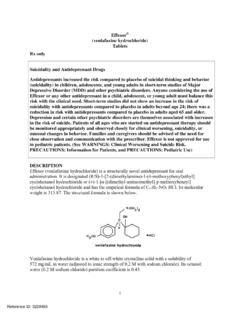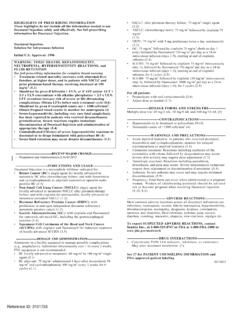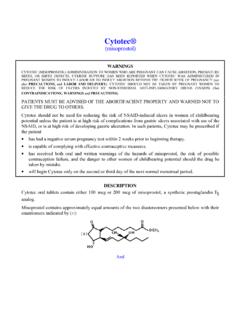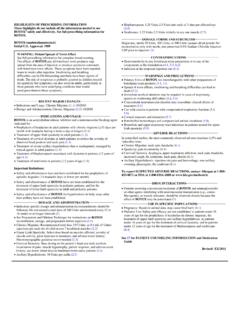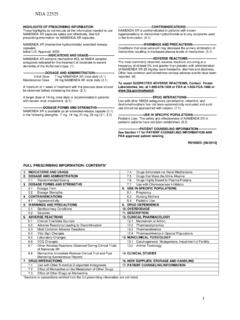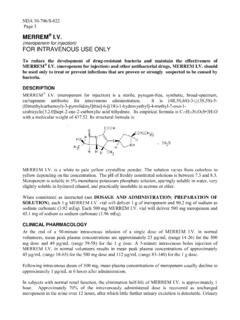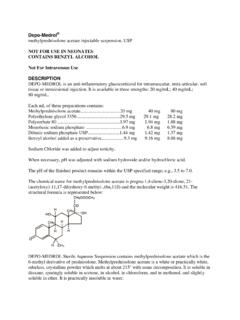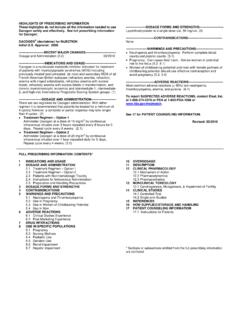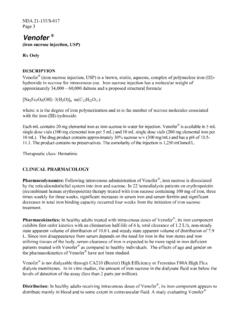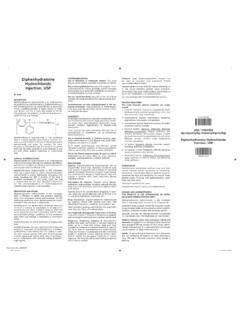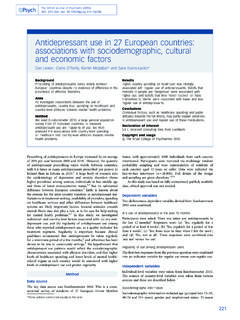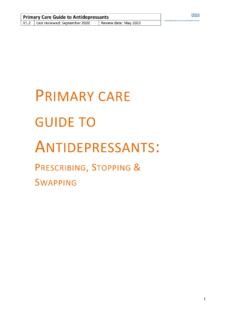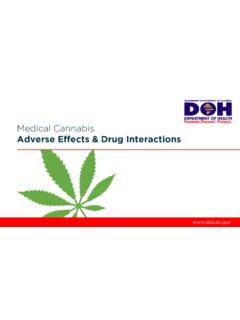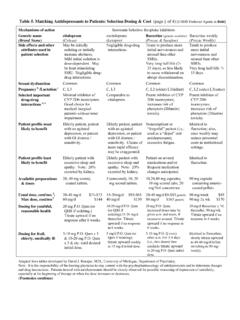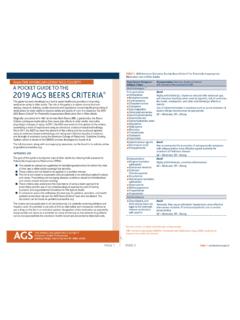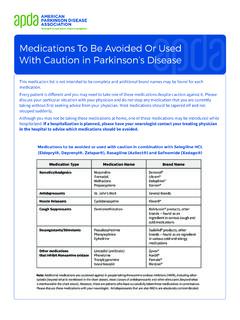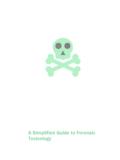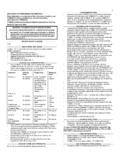Transcription of Phenergan - Food and Drug Administration
1 Phenergan . (promethazine HCI). Tablets and Suppositories only DESCRIPTION. Each tablet of Phenergan contains mg, 25 mg, or 50 mg promethazine HCl. The inactive ingredients present are lactose, magnesium stearate, and methylcellulose. Each dosage strength also contains the following: mg FD&C Yellow 6 and saccharin sodium;. 25 mg saccharin sodium;. 50 mg FD&C Red 40. Each rectal suppository of Phenergan contains mg, 25 mg, or 50 mg promethazine HCl with ascorbyl palmitate, silicon dioxide, white wax, and cocoa butter. Phenergan Suppositories are for rectal Administration only. Promethazine HCl is a racemic compound; the empirical formula is C17H20N2S HCl and its molecular weight is Promethazine HCl, a phenothiazine derivative, is designated chemically as 10H-Phenothiazine-10-ethanamine, N,N, -trimethyl-, monohydrochloride, ( )- with the following structural formula: Promethazine HCl occurs as a white to faint yellow, practically odorless, crystalline powder which slowly oxidizes and turns blue on prolonged exposure to air.
2 It is freely soluble in water and soluble in alcohol. CLINICAL PHARMACOLOGY. Promethazine is a phenothiazine derivative which differs structurally from the antipsychotic phenothiazines by the presence of a branched side chain and no ring substitution. It is thought that this configuration is responsible for its relative lack (1/10 that of chlorpromazine) of dopamine antagonist properties. Promethazine is an H1 receptor blocking agent. In addition to its antihistaminic action, it provides clinically useful sedative and antiemetic effects. Promethazine is well absorbed from the gastrointestinal tract. Clinical effects are apparent within 20. minutes after oral Administration and generally last four to six hours, although they may persist as long as 12 hours. Promethazine is metabolized by the liver to a variety of compounds; the sulfoxides of promethazine and N-demethylpromethazine are the predominant metabolites appearing in the urine.
3 INDICATIONS AND USAGE. Phenergan , either orally or by suppository, is useful for: Perennial and seasonal allergic rhinitis. Vasomotor rhinitis. Allergic conjunctivitis due to inhalant allergens and foods. Mild, uncomplicated allergic skin manifestations of urticaria and angioedema. Amelioration of allergic reactions to blood or plasma. Dermographism. Anaphylactic reactions, as adjunctive therapy to epinephrine and other standard measures, after the acute manifestations have been controlled. Preoperative, postoperative, or obstetric sedation. Prevention and control of nausea and vomiting associated with certain types of anesthesia and surgery. Therapy adjunctive to meperidine or other analgesics for control of post-operative pain. Sedation in both children and adults, as well as relief of apprehension and production of light sleep from which the patient can be easily aroused.
4 Active and prophylactic treatment of motion sickness. Antiemetic therapy in postoperative patients. CONTRAINDICATIONS. Phenergan Tablets and Suppositories are contraindicated for use in pediatric patients less than two years of age. Phenergan Tablets and Suppositories are contraindicated in comatose states, and in individuals known to be hypersensitive or to have had an idiosyncratic reaction to promethazine or to other phenothiazines. Antihistamines are contraindicated for use in the treatment of lower respiratory tract symptoms including asthma. WARNINGS. Phenergan SHOULD NOT BE USED IN PEDIATRIC PATIENTS LESS THAN 2 YEARS. OF AGE BECAUSE OF THE POTENTIAL FOR FATAL RESPIRATORY DEPRESSION. POSTMARKETING CASES OF RESPIRATORY DEPRESSION, INCLUDING FATALITIES, HAVE BEEN REPORTED WITH USE OF Phenergan IN PEDIATRIC PATIENTS LESS.
5 THAN 2 YEARS OF AGE. A WIDE RANGE OF WEIGHT-BASED DOSES OF Phenergan . HAVE RESULTED IN RESPIRATORY DEPRESSION IN THESE PATIENTS. CAUTION SHOULD BE EXERCISED WHEN ADMINISTERING Phenergan TO. PEDIATRIC PATIENTS 2 YEARS OF AGE AND OLDER. IT IS RECOMMENDED THAT. THE LOWEST EFFECTIVE DOSE OF Phenergan BE USED IN PEDIATRIC PATIENTS. 2 YEARS OF AGE AND OLDER AND CONCOMITANT Administration OF OTHER. DRUGS WITH RESPIRATORY DEPRESSANT EFFECTS BE AVOIDED. CNS Depression Phenergan Tablets and Suppositories may impair the mental and/or physical abilities required for the performance of potentially hazardous tasks, such as driving a vehicle or operating machinery. The impairment may be amplified by concomitant use of other central-nervous-system depressants such as alcohol, sedatives/hypnotics (including barbiturates), narcotics, narcotic analgesics, general anesthetics, tricyclic antidepressants, and tranquilizers; therefore such agents should either be eliminated or given in reduced dosage in the presence of promethazine HCl (see PRECAUTIONS Information for Patients and drug Interactions).
6 Respiratory Depression Phenergan Tablets and Suppositories may lead to potentially fatal respiratory depression. Use of Phenergan Tablets and Suppositories in patients with compromised respiratory function ( , COPD, sleep apnea) should be avoided. Lower Seizure Threshold Phenergan Tablets and Suppositories may lower seizure threshold. It should be used with caution in persons with seizure disorders or in persons who are using concomitant medications, such as narcotics or local anesthetics, which may also affect seizure threshold. Bone-Marrow Depression Phenergan Tablets and Suppositories should be used with caution in patients with bone-marrow depression. Leukopenia and agranulocytosis have been reported, usually when Phenergan (promethazine HCl) has been used in association with other known marrow-toxic agents.
7 Neuroleptic Malignant Syndrome A potentially fatal symptom complex sometimes referred to as Neuroleptic Malignant Syndrome (NMS) has been reported in association with promethazine HCl alone or in combination with antipsychotic drugs. Clinical manifestations of NMS are hyperpyrexia, muscle rigidity, altered mental status and evidence of autonomic instability (irregular pulse or blood pressure, tachycardia, diaphoresis and cardiac dysrhythmias). The diagnostic evaluation of patients with this syndrome is complicated. In arriving at a diagnosis, it is important to identify cases where the clinical presentation includes both serious medical illness ( pneumonia, systemic infection, etc.) and untreated or inadequately treated extrapyramidal signs and symptoms (EPS). Other important considerations in the differential diagnosis include central anticholinergic toxicity, heat stroke, drug fever and primary central nervous system (CNS) pathology.
8 The management of NMS should include 1) immediate discontinuation of promethazine HCl, antipsychotic drugs, if any, and other drugs not essential to concurrent therapy, 2) intensive symptomatic treatment and medical monitoring, and 3) treatment of any concomitant serious medical problems for which specific treatments are available. There is no general agreement about specific pharmacological treatment regimens for uncomplicated NMS. Since recurrences of NMS have been reported with phenothiazines, the reintroduction of promethazine HCl should be carefully considered. Use in Pediatric Patients Phenergan TABLETS AND SUPPOSITORIES ARE CONTRAINDICATED FOR USE IN. PEDIATRIC PATIENTS LESS THAN TWO YEARS OF AGE. CAUTION SHOULD BE EXERCISED WHEN ADMINISTERING Phenergan TABLETS.
9 AND SUPPOSITORIES TO PEDIATRIC PATIENTS 2 YEARS OF AGE AND OLDER. BECAUSE OF THE POTENTIAL FOR FATAL RESPIRATORY DEPRESSION. RESPIRATORY DEPRESSION AND APNEA, SOMETIMES ASSOCIATED WITH DEATH, ARE STRONGLY ASSOCIATED WITH PROMETHAZINE PRODUCTS AND ARE NOT. DIRECTLY RELATED TO INDIVIDUALIZED WEIGHT-BASED DOSING, WHICH MIGHT. OTHERWISE PERMIT SAFE Administration . CONCOMITANT Administration . OF PROMETHAZINE PRODUCTS WITH OTHER RESPIRATORY DEPRESSANTS HAS. AN ASSOCIATION WITH RESPIRATORY DEPRESSION, AND SOMETIMES DEATH, IN. PEDIATRIC PATIENTS. ANTIEMETICS ARE NOT RECOMMENDED FOR TREATMENT OF UNCOMPLICATED. VOMITING IN PEDIATRIC PATIENTS, AND THEIR USE SHOULD BE LIMITED TO. PROLONGED VOMITING OF KNOWN ETIOLOGY. THE EXTRAPYRAMIDAL. SYMPTOMS WHICH CAN OCCUR SECONDARY TO Phenergan TABLETS AND.
10 SUPPOSITORIES Administration MAY BE CONFUSED WITH THE CNS SIGNS OF. UNDIAGNOSED PRIMARY DISEASE, , ENCEPHALOPATHY OR REYE'S SYNDROME. THE USE OF Phenergan TABLETS AND SUPPOSITORIES SHOULD BE AVOIDED IN. PEDIATRIC PATIENTS WHOSE SIGNS AND SYMPTOMS MAY SUGGEST REYE'S. SYNDROME OR OTHER HEPATIC DISEASES. Excessively large dosages of antihistamines, including Phenergan Tablets and Suppositories, in pediatric patients may cause sudden death (see OVERDOSAGE). Hallucinations and convulsions have occurred with therapeutic doses and overdoses of Phenergan in pediatric patients. In pediatric patients who are acutely ill associated with dehydration, there is an increased susceptibility to dystonias with the use of promethazine HCl. Other Considerations Administration of promethazine HCl has been associated with reported cholestatic jaundice.
